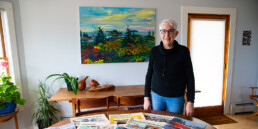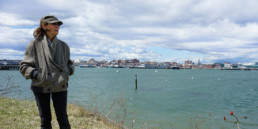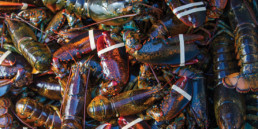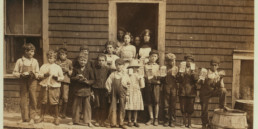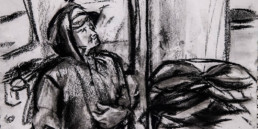My Garden in Your Backyard
Monhegan in late January is the antithesis of the island’s summertime buzz of endless work, activities and hordes of day-trippers. The days are short and bitter: the wind surges off the harbor and shakes the spruce and pushes against the house clapboards violently. And at night, with the stars frozen in the sky, there are only a couple of illuminated windows, many houses sitting quietly, dark and cold. And even though there’s a thin layer of icy snow on top of Kathie Iannicelli’s gardening plots, the Island Farm Project—her brainchild—is well under way for the year.
The 12-by-28-foot greenhouse—purchased and erected near the marsh in the center of the village last summer—is warm and secure and already full of chard, kale, and a lot of lettuce. Inside Kathie’s house, there are signs of the project everywhere. Dried herbs sit in glass jars in the pantry. Photos of blooming island flowers are taped to the walls. And in the mudroom, the master list of tasks to accomplish are scrawled, crossed out and annotated on a large chalkboard. These were the jobs that needed to be done to close out the 2012 season. Soon, though, this list will be erased and it will all start again: When the ground thaws in April, Kathie and her small crew of farmers will jump into action, turning soil, and creating a plan for growing and harvesting for the coming year.
It seems fitting that Monhegan has such a thriving gardening program considering that one of the first gardens in Maine was planted on the island in 1614 by Captain John Smith. He wrote, “I made a garden on top of a Rocky Isle in May that grew so well it served us salads in June and July.”

This will be the fourth season the farm project has been an active force on Monhegan, providing fresh produce to islanders and creating a culture of connectedness. But the project is at an important turning point: While they have figured out how to manage the project successfully and even turn a bit of a profit, they still consider it to be something of an experiment.
“My hope had been to make this into a business,” Kathie says. “For that to happen, we’d need to acquire more plots around the island and expand into something like a cooperative. We’re not quite there yet, but the next few years are going to be very exciting.”
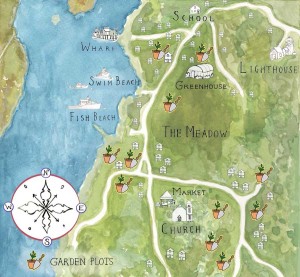
Kathie knows a thing or two about planting, growing, and nurturing a living thing. For over 25 years she has run her own gardening business on Monhegan, maintaining other people’s flowerbeds and vegetable gardens all around the island. She would prepare and plant and by the time people arrived for the summer, the gardens were ready to go. Tending to all of the properties gradually became a tall order for just one person, and she hired many helpers over the years, including Lillian Harris, a seasonal worker and a stalwart supporter of the Island Farm Project.
Lillian first came to Monhegan in the summer of 2004, taking a waitress job at the Island Inn during college. When she returned in the spring of 2009 to work at the Inn once again, she also started helping Kathie with her gardening business, as a way to supplement her income. While tending beds of flowers at neighboring cottages, they often discussed how great it would be to establish permanent plots around the island to grow vegetables. That struck a spark, and over the winter, Kathie started to put her plan into action: Identifying underutilized garden space, she came to agreements with several landowners, whereby they would receive shares of the harvest in exchange for the use of the property. By the time Lillian came back to Monhegan the following spring, the wheels of the Island Farm Project were already in motion.
It all started with a letter. Even though conversations about small vegetable gardens expanding into an island-wide farm had popped up with neighbors over the years, Kathie eventually sent a typewritten letter to everyone on the island, detailing what might be possible, potential actions to take, and wrapping up a list of answered questions with her own self-aware question: Do you know what you’re doing, Kathie? Her response was honest and optimistic: This is slightly overambitious and experimental, but my feelings are—that the time is right!
She struck a chord with some, and they immediately asked how they could help. Others were impressed with her ideas and effort, but wanted to wait to see how the project progressed before getting involved. The first season started slowly. Kathie hired an intern through the Maine Organic Farmers and Gardeners Association (MOFGA) and they set to work with the few plots they had. Gardening equipment was simple: hand tools and wheelbarrows. People would offer to lift something heavy or the use of their truck, but by and large, the prep work in the spring went essentially unnoticed. It wasn’t until the first farmer’s market rolled around that people saw what they were capable of.
Like the season itself, that market started quietly, in the rain and with only lettuce, because that was the only vegetable available at the end of June. But it also started very positively. People approached Kathie and her crew and said that they had been waiting years for something like this.
“You saw all that social interaction right away,” Kathie says. “And I thought, ‘Wow, I hadn’t anticipated that part of things.’ People got really excited.”

After that, the markets took off. For many on the island during the summer, it became the high point of the week, a chance for people to catch up on the church lawn and get excited about trying new food. What the success of the markets also did was light a fire under the whole community, invigorating retirees, kids, and fishermen alike. People started to help out with weeding or delivering produce or manning the market’s tables. Kathie estimates that of the roughly 55 people who live on Monhegan year-round, 80 percent of them have been involved, in one way or another.
And as the greenhouse was being built last summer, one year-round community member—who does a fair bit of gardening herself—approached Kathie and asked to use a small corner of the greenhouse in the winter. Now, two people, plus the three schoolchildren, have plots in there. In this way, it has also given any islander with a green thumb the chance to grow their own vegetables and keep themselves busy, especially in the winter when outdoor activities dwindle.
“It’s just one other way we can get people involved,” Kathie says, “to offer them a space and the fun of going over to a warm place to hang out when it’s freezing outside. The important thing is that we’re trying to do things with each other more often.”
The island’s 1,000 acres of rocky, but fertile, land once supported a good deal of agriculture, with potatoes being the chief crop. Even in the early 1800s, 80 acres of the island were still under cultivation; the island fed itself. As the island became more of an artists’ colony in the mid-19th century and the year-round population increased, more houses were built on tracts of farmable land.
Then, in the 1950s, Theodore Edison, who summered on the island for many years, purchased about 300 acres of the undeveloped areas and formed an organization, Monhegan Associates, which primarily acted as a land trust to protect the lands in perpetuity. In the past 50 years, Monhegan Associates has acquired more land through gifts and purchases, and at this point, they own approximately 480 acres of land, comprising about two-thirds of the island. That land is not developed, except for many miles of hiking trails going through it, which are open to the public.
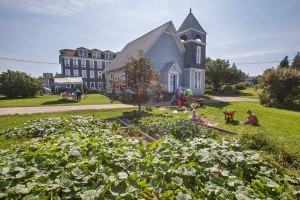
Kathie feels very strongly about striking a balance between protecting open space—what everyone on Monhegan calls the “wild lands”—and providing the opportunity for land use in the community. Although she agrees with the need to keep land undeveloped, she wants to make sure the island is used to its fullest potential. In their mission statement, the Monhegan Associates write that in addition to being dedicated to keeping the land forever wild, they are equally committed to “the simple, friendly way of life that has existed on Monhegan as a whole.”
“In my mind, when it was created there was the thought that saving everything is not the end,” Kathie says. “You have to cast an ear toward the needs of the people who live here.”
To their credit, Kathie says the Monhegan Associates have already been quite generous, donating several parcels toward the project, as well as giving land over to the electric company and the waste-management area of the island. And besides, the ways of growing food have changed; even though there aren’t dozens of farmable acres anymore, it can be accomplished just as well in smaller spaces and more intensively—precisely the way the Island Farm Project ended up working.
Last year, Lillian started working with the Monhegan Associates, and the position has allowed her to facilitate collaboration between the Associates and the project. In addition to being an extra set of hands wherever she can, Lillian takes on the role of de facto cheerleader, comfortable with public outreach.
“Kathie has done so much of this on her own; I don’t want to take credit for all that she’s done,” Lillian says. “But at the same time, I think it’s been nice for her to have a sounding board, as well as someone who says, ‘Hey, this is awesome! I want to tell people about it!’ ”
One of the people who got the message loud and clear was Ronnie Short. Like Lillian, the 27-year-old was looking for a summer job in 2006 and a friend recommended the Island Inn. He washed dishes in the kitchen for a while, then started cooking breakfast for the Inn’s guests. He got interested in gardening and, after several years of working on farms through Worldwide Opportunities on Organic Farms (WWOOF) in the U.S. and Europe, Ronnie finally ended up back on Monhegan. He started working at the Island Inn again, and then the following summer, at the Trailing Yew, another inn. When Ronnie came back in 2010, he saw how the project was progressing and wanted to get involved: He was getting the itch to garden. But he didn’t have the time or energy. He didn’t know Kathie too well, but when the summer season calmed down, he approached her, told her about his interest, and asked how they could start working together.
“She wasn’t cautious exactly,” Ronnie says, “but she said, ‘Hey, let’s go for a walk sometime.’ And we sat up on Horn Hill and she sort of interviewed me, wanted to know why I wanted to be a part of the farm, and why I liked Monhegan. I really liked her from that moment. I felt like she was a person who saw things more spiritually than just black and white.”
When he came back to the island the following summer, Kathie took Ronnie on as an intern, paying him a stipend while he continued his work at the Trailing Yew. He arrived in early April and lived with Lillian at Kathie’s house. For the first two months, it was nonstop seedling work and transplanting and working the soil in the new plots. Then there was a big push in the spring to get everything in the ground. Once everything was established, the rest of the summer was all about maintaining, weeding, and harvesting for both the farmer’s market and the CSA.
The CSA—an acronym used for community-supported agriculture—started as a way to provide produce to year-round residents who were, more often than not, working during the weekly farmer’s markets. The second year of the project, Kathie canvassed the island to gauge the interest in having produce delivered to people’s homes on a weekly basis. They had a few takers that year, and Kathie didn’t ask them to pay in advance because she knows that nobody has money in the spring. But now she figures that of the 30 or so year-round households, about half of them are current CSA subscribers.
At $10 to $12, the CSA bags are stuffed with potatoes, cucumbers, tomatoes, peppers, eggplants, zucchinis and all kinds of greens at the height of the summer season. There ends up being so much from the harvest that people have taken to recipe sharing to take care of the extra—hot pepper jelly, kale chips—and often, shares are given to people who have lent a hand.
“Anyone who helped harvest, helped at the farmer’s market, we encourage them to take something home,” Kathie says. “And because we have some land on the Monhegan House property, we’ll give them a bunch of bok choy or zucchini that was left over from the farmer’s market to use for their soups.”
Enthusiasm around the project has been so widespread that, gradually, collaborations around the island have begun. The first year, they started selling mustard greens and cilantro and cucumbers to Mattie Thompson for him to use at the shack where he sells fish tacos and French fries. Some neighbors offered up one of their pickup trucks, which has become the delivery vehicle for the CSA, as wheelbarrowing vegetables from one house to another can sometimes be a mile-long trek. The Monhegan Library has allowed them to set up a rain barrel to get water to the greenhouse. Jes Stevens has started to keep bees, and Kathie can often find them gathering in the squash blossoms and the flowers in her gardens, the hive effectively supporting her blooming crops. In the coming year, there is a plan to devote a bed to Cascade and Chinook hops for beer that Matt Weber is going to brew at his fledgling brewery on the island. As a trade, Matt will give Kathie the leftover mash from the brewing operation, which makes for excellent compost.
“The farming project is kind of like a center hub of this wheel, and you have these spokes going out to connect to all these project,s” Lillian says. “I think it helps to support these new projects, feeling like you’re not doing it all on your own and you’re not sort of working in a vacuum.”
Kathie is becoming more of an advisor, and while she’d like to continue her seedling work, she knows she needs to leave the hiking up hills and heavy digging to younger bodies. The hope is that working closely with young, committed farmers—like Lillian, Ronnie, and lifelong summer resident and new intern, Sue Jenkins—will be the answer to strengthening the momentum she’s helped establish. And as the farm project continues to evolve, it will undoubtedly attract more of those younger bodies, more people who are interested in getting their hands dirty—literally. Kathie calls it an inevitable hunger.
“People have gotten away from working physically and being in the ground and having that connection,” she says. “Now more than ever, there’s a lot of young people who want that hands-on life experience.”
For his part, Ronnie feels like he’s up for the task.
“I might not want to be doing this forever, but right now, I have faith that this project will bring positive energy to the community,” he says. “In the last couple years, as the project has become more of a big thing, I talk to people and they say, ‘Oh, I really want to be part of this.’ It’s turning into a huge part of what the island is all about.”
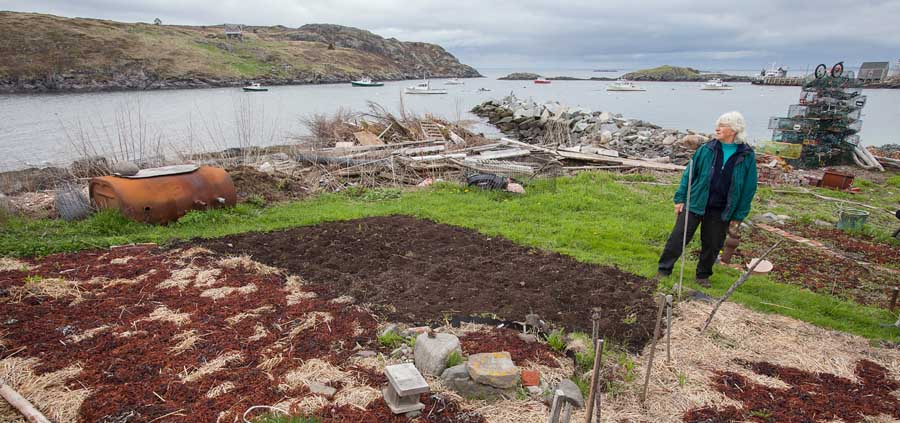
That is really what is at the heart of the farming project: an understanding that any islander or visitor or friend who wants to be involved, whether by donating pieces of their land for growing garlic or helping to erect the greenhouse, ends up being an integral part of the growing farming community. It’s as much about developing a village-wide enterprise as it is about healthy eating, cutting down on fossil fuels, or food independence from the mainland.

